by Bruce Wells | Oct 16, 2023 | This Week in Petroleum History
October 16, 1931 – Natural Gas Pipeline sets Record –
The first long-distance, high-pressure U.S. natural gas pipeline went into service during the Great Depression, linking prolific Texas Panhandle gas fields to consumers in Chicago.
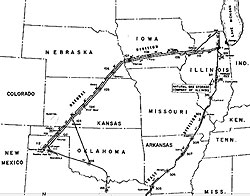
A 1931 natural gas pipeline extended 980 miles from North Texas to Illinois.
A.O. Smith Corporation developed the technology for a thin-walled pipe, and Continental Construction Corporation built the 980-mile bolted flange pipeline for the Natural Gas Pipeline Company of America (NGPL).
The $75 million high-tech pipeline project consumed 209,000 tons of specially fabricated 24-inch wide steel pipe, which filled 6,500 freight cars. The project required 2,600 separate right-of-way leases (also see Big Inch Pipelines of WWII).

October 17, 1890 – Union Oil of California founded
Lyman Stewart, Thomas Bard and Wallace Hardison founded the Union Oil Company of California by merging their petroleum properties to compete with Standard Oil of California (founded 20 years earlier). Union Oil made strategic alliances with small oil producers to build pipelines from Kern County oilfields to the Pacific coast.
“This gave the independent producers an alternative to what they perceived as the low prices paid by Standard Oil and the high freight rates charged by the railroads to move crude oil,” noted the American Institute of Mining in 1914. Union Oil moved the company headquarters from Santa Paula to Los Angeles in 1901.
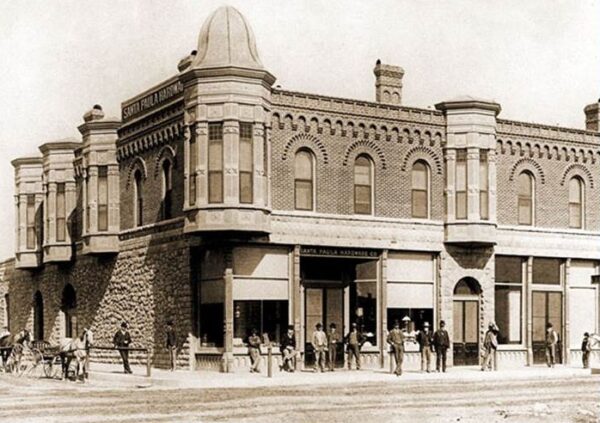
After becoming the Union Oil Museum in 1950, the company’s Santa Paula headquarters building in 1990 was restored to its original appearance and reopened as the California Oil Museum.
In 1910, Union Oil lost control of its Midway-Sunset field’s Lakeview No. 1 well, which would take 18 months to control. The purchase of Pennsylvania-based Pure Oil in 1965 made the Unocal Union 76 brand a nationwide company.
In 2005, Unocal became a subsidiary of Chevron. The Santa Paula company headquarters building, a California Historical Landmark, in 1990 became home to the California Oil Museum.
October 17, 1917 – “Roaring Ranger” launches Major Texas Drilling Boom
A wildcat well between Abilene and Dallas launched a Texas drilling boom that helped fuel the Allied victory in World War I. The J.H. McCleskey No. 1 well erupted oil about two miles south of the small town of Ranger, which had been founded in the 1870s near a Texas Ranger camp in Eastland County.

The 1917 McCleskey No. 1 oil gusher in Texas made headlines as the “Roaring Ranger” that helped win World War I.
Texas and Pacific Coal Company’s William Knox Gordon completed the discovery well at a depth of 3,432 feet. It initially produced 1,600 barrels a day of quality, high gravity oil. Within 20 months the exploration company’s stock value jumped from $30 a share to $1,250 a share.
“Roaring Ranger” launched a drilling boom that extended to nearby towns. More gushers followed, some producing up to 10,000 barrels of oil every day, and Ranger’s population grew from 1,000 to 30,000.

Eastland County discoveries included oil wells near Cisco, where Conrad Hilton bought his first hotel.
The petroleum proved essential in World War I. After the armistice was signed in 1918, a member of the British War Cabinet declared, “The Allied cause floated to victory upon a wave of oil.”
After the war, a veteran named Conrad Hilton visited Eastland County intending to buy a bank. When his deal fell through, Hilton — at the Cisco train station ready to leave — noticed a small hotel with a line of roughnecks waiting for a room (see Oil Boom Brings First Hilton Hotel).

October 17, 1973 – Embargo bring Gas Lines, Recession
Fifty years ago, the Organization of Petroleum Exporting Countries (OPEC) implemented what it called “oil diplomacy,” prohibiting any nation that had supported Israel in the Yom Kippur War from buying the cartel’s oil. The embargo brought an end to years of cheap gasoline and caused the New York Stock Exchange to drop by almost $100 billion. It also created one of the worst recessions in U.S. history. The United States became the world’s top petroleum producer in 2017, surpassing Russia and Saudi Arabia.
October 18, 2008 – Derrick dedicated in Discovery 1 Park
A re-enactment of the dramatic moment that changed Oklahoma history highlighted the 2008 dedication of a 84-foot replica derrick at Discovery 1 Park in Bartlesville, Oklahoma. Events included roughneck reenactors and a water gusher from an 84-foot derrick that replaced one dedicated in 1948.
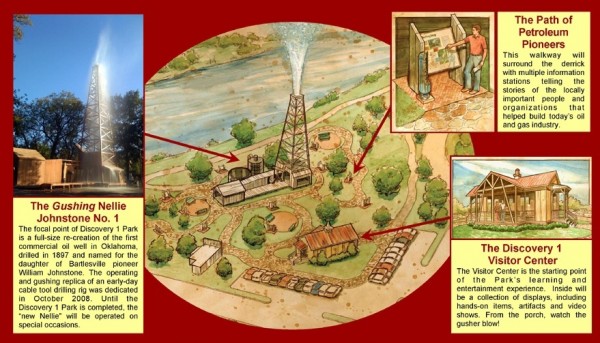
Discovery 1 Park in Bartlesville includes a replica derrick on the original site of Oklahoma’s first oil well.
In 1897, a cable-tool drilling rig at the site of Oklahoma’s first commercial oil well had thrilled another group of spectators when Jenny Cass, stepdaughter of Bartlesville founder George W. Keeler, was given the honor of “shooting” the well.
Today, the Bartlesville Community Foundation plans on adding a visitors center to Discovery 1 Park.
October 19, 1990 – First Emergency Use of Strategic Petroleum Reserve
As world oil prices spiked after the August 1990 invasion of Kuwait by Saddam Hussein’s Iraqi troops, the first presidentially mandated emergency use of the Strategic Petroleum Reserve was authorized by George H. W. Bush, who ordered sale of five million barrels of SPR oil as a test to “demonstrate the readiness of the system under real life conditions,” according to the Department of Energy.

The Strategic Petroleum Reserve’s four oil storage facilities are grouped into three geographical pipeline distribution systems
in Texas and Louisiana. Map courtesy U.S. Department of Energy, Report to Congress, December 2018.
President Ford established the SPR in 1975 as a protection against severe supply interruptions. By 2020, four underground salt dome sites along the Gulf Coast stored 735 million barrels of oil — the largest stockpile of government-owned emergency oil in the world.
October 20, 1944 – Liquefied Natural Gas Tank explosion in Ohio
An explosion and fire from liquefied natural gas tanks in Cleveland, Ohio, killed 131 people and caused more than $10 million in damage. Temperatures inside of one of the East Ohio Gas Company’s tanks reportedly had been allowed to fall below minus 250 degrees, which caused the steel plates to contract and rupture. Investigators never discovered a cause for the explosion, but witnesses reported a leak in one of the tanks, according to Ohio History Central. “Some spark must have then ignited the gas, although, with World War II currently raging, some residents initially suspected a German saboteur.”

October 20, 1949 – Maryland produces Some Natural Gas
The first commercially successful natural gas well in Maryland was drilled by the Cumberland Allegheny Gas Company in the town of Mountain Lake Park, Garrett County — the westernmost county in the state. The Elmer Beachy well produced about 500 thousand cubic feet of natural gas a day.

No oil has been produced in Maryland.
The discovery well prompted a rush of competing companies and high-density drilling (an average of nine wells per acre), which depleted the field. Twenty of 29 wells drilled within the town produced natural gas, but overall production from the field was low. No oil has been found in Maryland.
October 21, 1921 – First Natural Gas Well in New Mexico
New Mexico’s natural gas industry began when the newly formed Aztec Oil Syndicate’s State No. 1 well found gas reserves about 15 miles northeast of Farmington in San Juan County.
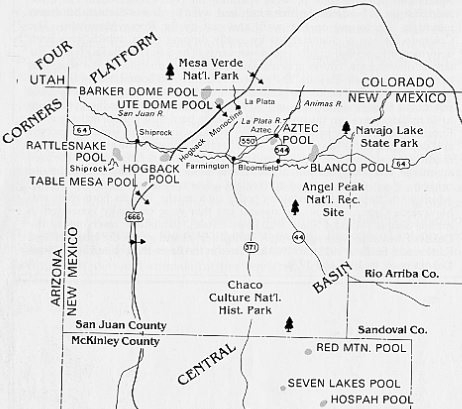
New Mexico’s first commercial natural gas service began after a 1921 discovery near Aztec. Oil discoveries followed in the southeast.
The drilling crew used a trimmed tree trunk with a two-inch pipe and shut-off valve to control the well until a wellhead was shipped in from Colorado. The well produced 10 million cubic feet of natural gas a day.
By the end of December 1921, a pipeline reached two miles into the town of Aztec, where citizens enjoyed New Mexico’s first commercial natural gas service. In 1922, natural gas could be purchased in Aztec at a flat rate of $2 a month (for a gas heater) and $2.25 (for a gas stove).
Learn more about the state’s petroleum history in New First Mexico Oil Wells.
_______________________
Recommended Reading: Oil and Gas Pipeline Fundamentals (1993); The 76 bonanza: The fabulous life and times of the Union Oil Company of California
(1993); The 76 bonanza: The fabulous life and times of the Union Oil Company of California (1966); Ranger, Images of America
(1966); Ranger, Images of America (2010); Desert Kingdoms to Global Powers: The Rise of the Arab Gulf
(2010); Desert Kingdoms to Global Powers: The Rise of the Arab Gulf (2016); Bartlesville, Oklahoma, Postcard History Series
(2016); Bartlesville, Oklahoma, Postcard History Series  (2000); Oil in West Texas and New Mexico
(2000); Oil in West Texas and New Mexico (1982). Your Amazon purchase benefits the American Oil & Gas Historical Society. As an Amazon Associate, AOGHS earns a commission from qualifying purchases.
(1982). Your Amazon purchase benefits the American Oil & Gas Historical Society. As an Amazon Associate, AOGHS earns a commission from qualifying purchases.
_______________________
The American Oil & Gas Historical Society (AOGHS) preserves U.S. petroleum history. Become an AOGHS annual supporting member and help maintain this energy education website and expand historical research. For more information, contact bawells@aoghs.org. Copyright © 2023 Bruce A. Wells. All rights reserved.
by Bruce Wells | Oct 9, 2023 | This Week in Petroleum History
October 9, 1999 – Converted Offshore Platform launches Rocket –
Sea Launch, a Boeing-led consortium of companies from the United States, Russia, Ukraine and Norway, launched its first commercial rocket using the Ocean Odyssey, a modified semi-submersible drilling platform. After a demonstration flight in March, a Russian Zenit-3SL rocket carried a DirecTV satellite to geostationary orbit.
In 1988, the former drilling platform had been used by Atlantic Richfield Company (ARCO) for North Sea explorations. The Ocean Odyssey made 36 more rocket launches until 2014, when the consortium ended after Russia illegally annexed Ukraine’s Crimean peninsula.
Learn more in Offshore Rocket Launcher. (more…)
by Bruce Wells | Oct 2, 2023 | This Week in Petroleum History
October 2, 1919 – Future “Mr. Tulsa” incorporates Skelly Oil –
Skelly Oil Company incorporated in Tulsa, Oklahoma, with founder William Grove Skelly as president. He had been born in 1878 in Erie, Pennsylvania, where his father hauled oilfield equipment in a horse-drawn wagon.

Born near Pennsylvania’s early oilfields, independent oilman William Skelly’s company helped make Tulsa the “Oil Capital of the World.”
Skelly’s success in the El Dorado oilfield east of Wichita, Kansas, helped him launch Skelly Oil and other ventures, including Midland Refining Company, which he founded in 1917. As Tulsa promoted itself as “Oil Capital of the World,” Skelly became known as “Mr. Tulsa.”
Skelly served as president of Tulsa’s famous International Petroleum Exposition for 32 years until his death in 1957.

October 3, 1930 – East Texas Oilfield discovered on Widow’s Farm
With a crowd of more than 4,000 landowners, leaseholders, creditors, and spectators watching, the Daisy Bradford No. 3 remote wildcat well was successfully shot with nitroglycerin near Kilgore, Texas.

Spectators gathered on the widow Daisy Bradford’s farm near Kilgore, Texas, to watch the October 3, 1930, “shooting” of the discovery well of what proved to be the largest oilfield in the lower-48 states. Photo courtesy Jack Elder, The Glory Days.
“All of East Texas waited expectantly while Columbus ‘Dad’ Joiner inched his way toward oil,” explained historian Jack Elder in 1986. “Thousands crowded their way to the site of Daisy Bradford No. 3, hoping to be there when and if oil gushed from the well to wash away the misery of the Great Depression.” (more…)
by Bruce Wells | Sep 18, 2023 | This Week in Petroleum History
September 18, 1855 – First U.S. Oil Company reorganizes –
In need of more capital, George Bissell and partner Jonathan Eveleth reorganized their New York-based Pennsylvania Rock Oil Company — America’s first oil exploration company — into the Seneca Oil Company of New Haven, Connecticut. They continued to seek investors for drilling a well to produce oil that could be refined into kerosene.
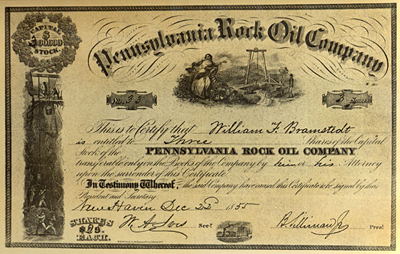
America’s first oil company, Pennsylvania Rock Oil Company, reorganized as Seneca Oil Company of New Haven Connecticut in 1858, one year before drilling the first U.S. Well.
The Pennsylvania Rock Oil Company had been established in 1854 to drill a well near Titusville (see George Bissell’s Oil Seeps). The re-incorporated business replaced New York City’s capital markets, which had shown little interest in drilling for oil, seen as too speculative.
Seneca Oil hired former railroad conductor Edwin L. Drake, who overcame financial and technical obstacles to complete the first U.S. oil well in August 1859.

September 18, 1948 – Oil discovered in Utah
J.L. “Mike” Dougan, president of the Equity Oil Company, completed Utah’s first significant oil well. Dougan’s small company outcompeted larger and better financed exploration companies, including Standard Oil of California (Socal), Pure Oil, Continental, and Union Oil. His Uinta Basin oilfield discovery launched a deep-drilling boom in Utah.
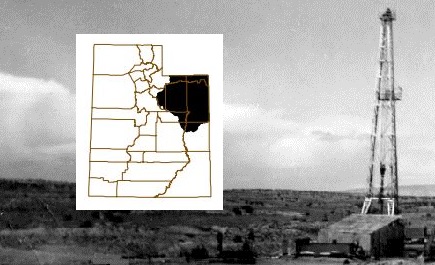
Begun in 1948 in the giant Uinta Basin, Utah’s petroleum industry continues today thanks to reserves of coalbed methane gas.
Unlike earlier attempts, Dougan drilled beyond the typical depth of up to 2,000 feet. His Ashley Valley No. 1 well, 10 miles southeast of Vernal, produced 300 barrels of oil a day from about 4,000 feet.
Uinta Basin production soon averaged almost one million barrels of oil a year from 30 wells. As drilling technologies advanced, companies began drilling to 8,000 feet and deeper.
Learn more in First Utah Oil Wells.
September 21, 1901 – First Louisiana Oil Well
Nine months after the headline-making January 1901 “Lucas Gusher” in Texas, another giant oilfield was revealed 90 miles east in Louisiana. W. Scott Heywood — already successful thanks to wells drilled at Spindletop Hill — completed a wildcat well that produced 7,000 barrels of oil a day well on the farm of Jules Clement.
Drilled six miles northeast of Jennings, the Clement No. 1 found oil at a depth of 1,700 feet. “The well flowed sand and oil for seven hours and covered Clement’s rice field with a lake of oil and sand, ruining several acres of rice,” noted the Jennings Daily News.

Mrs. Scott Heywood unveiled a marker as part of the Louisiana Golden Oil Jubilee in 1951. Times Picayune (New Orleans) image courtesy Calcasieu Parish Public Library.
The discovery led to the state’s first commercial oil production by opening the prolific Jennings field, which Haywood further developed by building pipelines and storage tanks. As the oilfield reached peak production of more than nine million barrels of oil in 1906, more discoveries arrived in northern Louisiana.
Learn more in First Louisiana Oil Wells.

September 22, 1955 – End of Signal Oil’s “The Whistler” Radio Program
Sponsored since 1942 by the largest independent oil company on the West Coast, the last episode of the radio drama “The Whistler” aired on CBS Radio. Signal Oil Company had been established in 1921 by Samuel Mosher as Signal Gasoline Company during California’s Signal Hill oil boom.
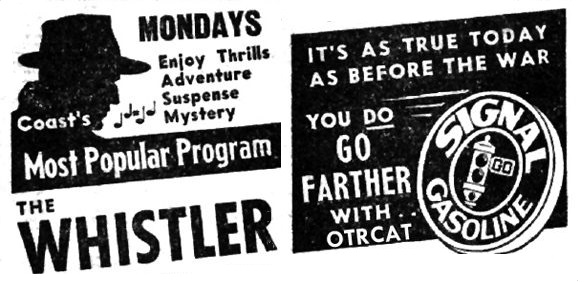
Signal Oil Company sponsored a CBS Radio mystery program beginning in 1942.
The company’s 1931 partnership with Standard Oil of California (Socal) led to sponsorship of many radio programs, according to Media Heritage. The 692 episodes of Signal Oil’s weekly radio mystery began with echoing footsteps and an eerie whistle, followed by “That Whistle is your signal for the Signal Oil program.”
September 23, 1918 – Giant Wood River Refinery goes Online
Roxana Petroleum Company’s Wood River (Illinois) facility began refining crude oil. It processed more than two million barrels of oil from Oklahoma oilfields in its first year of operation.
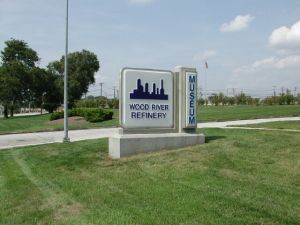
The Wood River Refinery History Museum is in front of the Phillips 66 Refinery southeast of Roxana, Illinois.
Roxana Petroleum Company was the 1912 creation of the Royal Dutch/Shell Group, which founded the American Gasoline Company in Seattle to distribute the fuel on the West Coast.
Roxana Petroleum was established in Oklahoma to produce high-quality oil to be refined at the Wood River plant. In West Texas, the company in 1928 built an experimental oil storage reservoir (see Million Barrel Museum).
Today, the Wood River 2,200-acre refinery at Roxana northeast of St. Louis is the largest owned by Phillips 66.
Visit the Wood River Refinery History Museum.

September 23, 1933 – Standard Oil of California Geologists visit Saudi Arabia
Invited by Saudi Arabian King Abdel Aziz, geologists from Standard Oil Company of California arrived at the Port of Jubail in the Persian Gulf. Searching the desert for petroleum and “kindred bituminous matter,” they discovered a giant oilfield. The Saudi Arabia and Standard Oil partnership would become the Arabian American Oil Company (Aramco), later joined by other major U.S. companies.
September 23, 1947 – New Patent for “Hortonspheres”
Horace E. Horton’s Chicago Bridge & Iron Company (CB&I) received a patent for improvements to a spherical storage vessel he had invented in the 1920s. Designed to efficiently store natural gas, butane, propane and other volatile petroleum products, the large spheres were among the most important storage innovations to come to the U.S. oil and natural gas industry.
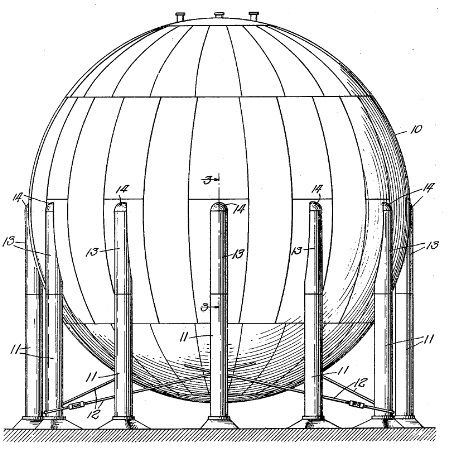
Horace Ebenezer Horton (1843-1912) founded the company that would build the world’s first “field-erected spherical pressure vessel.”
CB&I named its “Hortonspheres” after the engineer who had started the company in 1889 to build bridges across the Mississippi River. In 1892, CB&I erected its first elevated water tank in Fort Dodge, Iowa.
“The elevated steel plate tank was the first built with a full hemispherical bottom, one of the company’s first technical innovations,” CB&I noted, adding that company built, “the world’s first field-erected spherical pressure vessel” in 1923 at Port Arthur, Texas.
Learn more in Horace Horton’s Spheres.
September 24, 1951 – Perforating Wells with Bazooka Technology
When World War II veteran Henry Mohaupt applied to patent his “Shaped Charge Assembly and Gun,” he brought anti-tank technology to the petroleum industry — a downhole bazooka.
Mohaupt, a Swiss-born chemical engineer, during the war had conducted a secret U.S. Army program to develop an anti-tank weapon. His idea of using a conically hollowed out explosive charge to focus detonation energy led to the rocket grenade used in bazookas.

The patented “Shaped Charge Assembly and Gun” of Henry Mohaupt brought to the oil patch his highly successful anti-tank “bazooka” technology of World War II.
After the war, the potential of these downhole rocket grenades to facilitate flow from oil-bearing strata was recognized by the Well Explosives Company of Fort Worth, Texas. The company employed Mohaupt to develop new technologies for safely perforating cement casing and pipe.
Learn more in Downhole Bazooka.

_______________________
Recommended Reading: Myth, Legend, Reality – Edwin Laurentine Drake and the Early Oil Industry (2009); Utah Oil Shale: Science, Technology, and Policy Perspectives
(2009); Utah Oil Shale: Science, Technology, and Policy Perspectives (2016); Louisiana’s Oil Heritage, Images of America
(2016); Louisiana’s Oil Heritage, Images of America (2012); Signal Hill, California – Images of America
(2012); Signal Hill, California – Images of America (2006); Handbook of Petroleum Refining Processes
(2006); Handbook of Petroleum Refining Processes (2016); The Bazooka
(2016); The Bazooka (2012). Your Amazon purchase benefits the American Oil & Gas Historical Society. As an Amazon Associate, AOGHS earns a commission from qualifying purchases.
(2012). Your Amazon purchase benefits the American Oil & Gas Historical Society. As an Amazon Associate, AOGHS earns a commission from qualifying purchases.
_______________________
The American Oil & Gas Historical Society (AOGHS) preserves U.S. petroleum history. Become an AOGHS annual supporting member and help maintain this energy education website and expand historical research. For more information, contact bawells@aoghs.org. Copyright © 2023 Bruce A. Wells. All rights reserved.








(1993); The 76 bonanza: The fabulous life and times of the Union Oil Company of California
(1966); Ranger, Images of America
(2010); Desert Kingdoms to Global Powers: The Rise of the Arab Gulf
(2016); Bartlesville, Oklahoma, Postcard History Series
(2000); Oil in West Texas and New Mexico
(1982). Your Amazon purchase benefits the American Oil & Gas Historical Society. As an Amazon Associate, AOGHS earns a commission from qualifying purchases.











